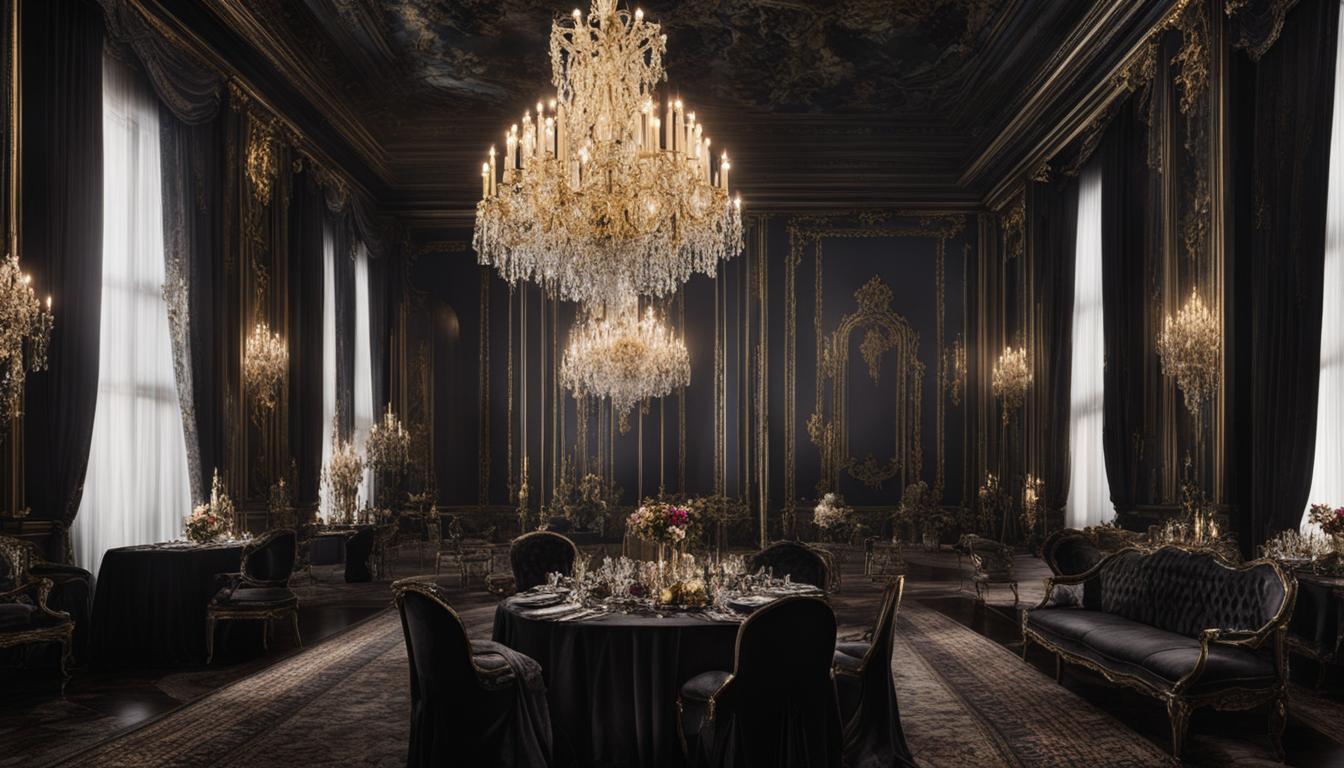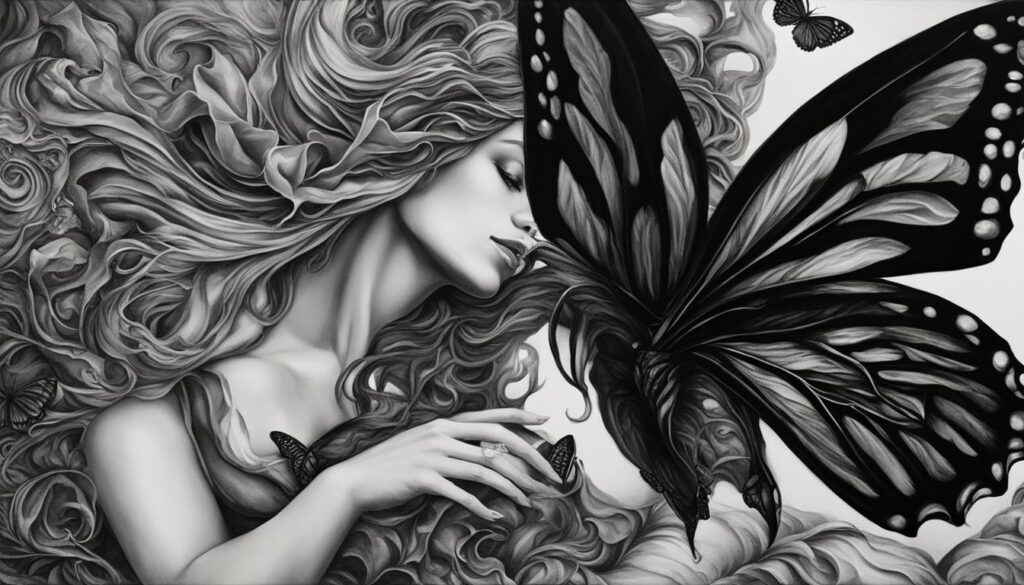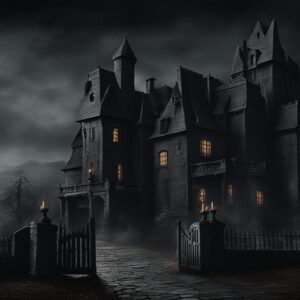As a fan of classic films, I have always been captivated by the timeless beauty and depth of storytelling that black and white movies offer. One film that stands out in this regard is the 1945 adaptation of Oscar Wilde’s only novel, The Picture of Dorian Gray. This visually striking masterpiece showcases the art of black-and-white cinematography at its finest, transporting viewers to the enchanting world of late-Victorian London.
The Picture of Dorian Gray (1945) follows the haunting tale of Dorian Gray, a man whose portrait ages and decays while he remains eternally young and beautiful. The film’s meticulous attention to detail, from the exquisite costumes to the atmospheric sets, adds to the overall elegance and authenticity of the story. The performances by the talented cast, including Hurd Hatfield as Dorian Gray, George Sanders as Lord Henry, and Angela Lansbury as Sibyl Vane, bring a depth and nuance to the characters, making them truly memorable.
This adaptation of Wilde’s work is not only visually stunning but also serves as a chilling psychological study of human nature. It delves into the consequences of vanity, hedonism, and the pursuit of pleasure without regard for morality. The story raises thought-provoking questions about the intricacies of beauty and morality, as well as the power of art and its potential to corrupt.
Overall, The Picture of Dorian Gray (1945) is a testament to the enduring legacy of Oscar Wilde’s literary masterpiece. Its black and white cinematography, enigmatic characters, and exploration of moral corruption continue to captivate audiences today. Join me on a journey through this timeless film as we delve into its stunning visuals, stellar performances, and thought-provoking themes.
Key Takeaways:
- The Picture of Dorian Gray (1945) is a visually striking black and white film adaptation of Oscar Wilde’s only novel.
- The movie showcases the art of black-and-white cinematography and raises the bar for visual aesthetics.
- The cast delivers stellar performances, bringing depth and nuance to their characters.
- The film immerses viewers in the atmospheric setting of late-Victorian London.
- The story explores the destructive nature of vanity and the consequences of pursuing pleasure without morality.
A Stunning Visual Masterpiece
The Picture of Dorian Gray (1945) is renowned for its breathtaking black and white cinematography. The elegant use of deep-focus photography and the exquisite attention to lighting and shadow create a visually striking experience for the audience. The contrast between light and dark, emphasized by the absence of color, adds depth and texture to the film, enhancing its overall aesthetic appeal.
The meticulous attention to detail is evident in the intricate costumes and sets, which transport viewers to the late-Victorian era of London. The period atmosphere, combined with the elegant cinematography, immerse the audience in the world of Dorian Gray, heightening the impact of the story and adding to the overall beauty of the film.
Furthermore, the use of black and white film allows for a heightened focus on the emotions and expressions of the characters. Without the distraction of color, the audience can fully appreciate the nuances in the performances, bringing a sense of realism and depth to the film.
Achieving Timeless Beauty
The stunning visual elements of The Picture of Dorian Gray (1945) contribute to its status as a timeless masterpiece. The elegant cinematography, deep-focus photography, and impeccable attention to detail create a feast for the eyes, captivating audiences then and now.
Stellar Performances by the Cast
The cast of The Picture of Dorian Gray (1945) delivers stellar performances, bringing the characters to life with depth and nuance. Hurd Hatfield shines in the role of Dorian Gray, capturing both his youthful charm and the dark depths of his soul. Hatfield’s portrayal portrays Dorian’s transformation from an innocent young man to a corrupt and morally decayed individual, firmly establishing him as the central character of the film. His nuanced performance truly resonates with the audience, allowing them to empathize with the complexity of Dorian’s journey.
George Sanders delivers Oscar Wilde’s cynical yet witty observations about human nature with precision and elegance in his portrayal of Lord Henry Wotton. Sanders’ performance adds a layer of sophistication to the film, as he effortlessly delivers Wilde’s sharp and thought-provoking dialogue. His character serves as the catalyst for Dorian’s descent into hedonism, making Sanders’ performance crucial to the narrative’s progression.
Angela Lansbury brings a touching vulnerability to her role as Sibyl Vane, the young actress who falls in love with Dorian Gray. Lansbury’s performance captures the innocence and naivety of Sibyl, making her tragic storyline all the more compelling. She expertly portrays the emotional turmoil of her character, creating a believable and empathetic portrayal.
Donna Reed, Peter Lawford, and the rest of the supporting cast also deliver commendable performances, contributing to the overall excellence of the acting in The Picture of Dorian Gray. Their contributions to the film add depth to the story and enhance the viewer’s immersion in the world of late-Victorian London.
The stellar performances of the cast in The Picture of Dorian Gray (1945) elevate the film to new heights. Hurd Hatfield, George Sanders, Angela Lansbury, Donna Reed, Peter Lawford, and the rest of the ensemble bring their characters to life with passion and skill, creating a memorable cinematic experience for audiences.
Table: Main Cast of The Picture of Dorian Gray (1945)
| Actor | Character |
|---|---|
| Hurd Hatfield | Dorian Gray |
| George Sanders | Lord Henry Wotton |
| Angela Lansbury | Sibyl Vane |
| Donna Reed | Gladys Hallward |
| Peter Lawford | David Stone |
A Deep Dive into Late-Victorian London
In The Picture of Dorian Gray (1945), the setting of late-Victorian London serves as a crucial component of the film, contributing to its overall atmosphere and authenticity. The meticulous attention to detail in the film’s sets and costumes immerses viewers in the vibrant world of late 19th-century London. The period atmosphere, with its ornate architecture, gas-lit streets, and intricate costumes, transports the audience to a bygone era.
Through the evocative visuals, the film captures the essence of the late-Victorian period, reflecting the societal norms and values that shaped the characters’ experiences. The opulence of the upper-class establishments and the stark contrast of the impoverished neighborhoods create a sense of social hierarchy and class divide. This contrast adds depth to the narrative, highlighting the moral decay and corruption that lurks beneath the city’s elegant facade.
Moreover, the accurate portrayal of late-Victorian London enhances the film’s storytelling, providing a rich backdrop against which the characters’ actions and motivations unfold. The historical context adds depth to the narrative, further emphasizing the consequences of Dorian Gray’s pursuit of pleasure and the moral choices he makes along the way.
The Period Atmosphere of Late-Victorian London in The Picture of Dorian Gray (1945)
In the film, late-Victorian London is brought to life through meticulously designed sets and costumes. The ornate Victorian architecture and the cobblestone streets create an immersive experience, transporting viewers back in time. The gas-lit alleyways and dimly lit interiors add an air of mystery and intrigue to the narrative, enhancing the overall atmosphere of the film.
| Aspect | Details |
|---|---|
| Architecture | The film showcases the grandeur of Victorian architecture, with its intricate details, ornate facades, and towering structures. The opulence of the upper-class establishments contrasts with the dilapidated buildings of the impoverished neighborhoods. |
| Costumes | The elaborate costumes worn by the characters reflect the fashion trends of the late-Victorian era. The rich fabrics, intricate designs, and attention to detail transport viewers to a time when appearance and social status were of paramount importance. |
| Street Scenes | The film captures the bustling streets of late-Victorian London, with horse-drawn carriages, street vendors, and crowds of people. The attention to detail in recreating the street scenes helps to create an immersive experience, drawing viewers into the world of the film. |
The period atmosphere of late-Victorian London in The Picture of Dorian Gray (1945) not only serves as a backdrop for the story but also as a reflection of the characters’ inner turmoil and the moral decay of society. This attention to detail adds depth and authenticity to the film, enhancing the overall viewing experience.
A Chilling Psychological Study of Human Nature
The Picture of Dorian Gray (1945) is not just a Gothic horror film; it also delves into the depths of human psychology. The story serves as a chilling study of a man influenced by evil and the consequences of his actions. The character of Dorian Gray undergoes a transformation, descending into a world of moral decay and depravity that is both captivating and unnerving.
The film explores the dark recesses of the human psyche, challenging viewers to confront their own capacity for evil. As Dorian Gray indulges in a life of hedonism and pleasure-seeking, we witness the gradual deterioration of his soul. The psychological thriller aspect of the story keeps audiences on the edge of their seats, as they are forced to question the nature of humanity and the choices we make.
Through the mesmerizing performances of the cast, coupled with the film’s atmospheric cinematography and haunting score, The Picture of Dorian Gray (1945) presents a stark examination of human nature. It delves into the moral complexities and psychological depths of its characters, leaving a lasting impression on the audience. This psychological study of human nature continues to resonate with viewers, reminding us of the fragility of our own morality and the consequences of unchecked desires.
As we journey through the twisted mind of Dorian Gray, we are confronted with the chilling realization that the line between good and evil is not always clear-cut. The film serves as a cautionary tale, warning against the temptations of immorality and the destructive power of one’s own desires. It raises thought-provoking questions about the nature of evil and the depths to which humanity can sink.
A Timeless Tale of Vanity and Hedonism
The central themes of The Picture of Dorian Gray (1945) revolve around the destructive nature of vanity and hedonism. The film explores the moral corruption that comes from valuing youth and beauty above all else. Dorian Gray’s pursuit of pleasure without regard for ethics leads to dire consequences, showing the high cost of indulging in a life of sin and vice.
Throughout the movie, we witness Dorian’s descent into moral decay and the consequences that follow. His obsession with his own beauty and the pleasures of life blinds him to the impact his actions have on those around him. As he engages in a life of hedonism, he becomes increasingly detached from empathy and compassion, ultimately leading to his own downfall.
The film serves as a cautionary tale, warning against the dangers of unchecked vanity and the pursuit of pleasure at the expense of others. It challenges societal norms and asks the audience to reflect on their own values and choices. The consequences of Dorian’s pleasure-seeking behavior highlight the importance of maintaining a balance between self-indulgence and moral responsibility.
The Moral Corruption of Vanity and Hedonism
“But beauty, real beauty, ends where an intellectual expression begins. Intellect is in itself a mode of exaggeration, and destroys the harmony of any face.”
| Themes | Description |
|---|---|
| Moral Corruption | The film explores the consequences of valuing beauty above morality, showcasing the corrupting influence of vanity and hedonism on Dorian Gray. |
| Vanity | Dorian’s obsession with his own beauty leads him to abandon moral standards, causing him to prioritize his appearance above all else. |
| Hedonism | The pursuit of pleasure without regard for ethics or consequences is depicted as a destructive force, leading to moral decay and personal downfall. |
| Consequences | The film highlights the harsh consequences of pleasure-seeking behavior, serving as a cautionary tale about the high cost of indulgence. |
Enigmatic Characters and Their Influence on Dorian Gray
In The Picture of Dorian Gray, the enigmatic characters of Basil Hallward and Lord Henry Wotton play significant roles in shaping Dorian Gray’s life and choices. Basil, the painter of Dorian’s portrait, represents conformity to moral standards and serves as a moral compass for Dorian. He sees the potential for good in Dorian and hopes to guide him onto a virtuous path. However, his influence is ultimately overshadowed by Lord Henry’s seductive charm and philosophical beliefs.
“It is a great mistake to think that the art of our time is merely the expression of contemporary life… No artist desires to prove anything. Even things that are true can be proved. No artist has ethical sympathies. An ethical sympathy in an artist is an unpardonable mannerism of style.” – Lord Henry Wotton
Lord Henry Wotton, a witty aristocrat, represents the temptations of hedonism and the pursuit of pleasure without regard for morality. His influence on Dorian is profound, as he encourages Dorian to embrace a life of indulgence and the relentless pursuit of beauty. Lord Henry’s cynicism and wit captivate Dorian, leading him down a path of moral corruption and self-destruction.
The interplay between Basil and Lord Henry mirrors the conflict within Dorian himself. Dorian is torn between the desire for virtue represented by Basil and the allure of a life of hedonism represented by Lord Henry. This internal struggle drives the narrative and raises questions about the nature of human morality and the choices individuals make.
| Character | Role |
|---|---|
| Dorian Gray | The central character who is influenced by Basil and Lord Henry |
| Basil Hallward | Painter of Dorian’s portrait, represents conformity to moral standards |
| Lord Henry Wotton | Witty aristocrat who represents the temptations of hedonism |
The complex relationships between these characters provide a rich tapestry for exploring the themes of morality, influence, and the consequences of one’s choices. As Dorian Gray becomes entangled in their conflicting ideologies, the novel delves into the depths of human nature and the transformative power of influence.
The Intrigue of Basil Hallward
Basil Hallward serves as a source of guidance and moral compass for Dorian Gray. He is captivated by Dorian’s beauty and innocence, and as the painter of Dorian’s portrait, he becomes emotionally invested in Dorian’s life. Basil represents the voice of virtue and moral standards, urging Dorian to live a life of goodness and resisting the allure of hedonism. However, Basil’s influence is ultimately eclipsed by the seductive power of Lord Henry Wotton.
The Temptations of Lord Henry Wotton
Lord Henry Wotton, a charming aristocrat, becomes the catalyst for Dorian’s descent into moral corruption. His eloquence and philosophical beliefs captivate Dorian, leading him to embrace a life of pleasure-seeking without regard for the consequences. Lord Henry’s influence transforms Dorian from a naive young man into a hedonistic and morally bankrupt individual. The character of Lord Henry raises profound questions about the dangers of unchecked desires and the allure of a life without moral constraints.
Through the interplay of these enigmatic characters, The Picture of Dorian Gray explores the complexities of human nature and the power of influence. The contrasting ideologies of Basil and Lord Henry provide a rich backdrop for examining the choices individuals make and the consequences that follow. As Dorian Gray grapples with the conflicting influences of virtue and hedonism, his journey becomes a cautionary tale about the dangers of unchecked desires and the moral decay that can result.
The Intricacies of Beauty and Morality
The Picture of Dorian Gray (1945) delves into the intricate relationship between beauty and morality. The story revolves around Dorian Gray, a man who becomes consumed by his own beauty and abandons moral standards in pursuit of pleasure. This exploration of beauty versus virtue raises questions about the superficiality of external appearances and the moral consequences of valuing beauty above all else.
The Superficiality of Beauty
In the world of The Picture of Dorian Gray, beauty is highly valued, but its significance goes beyond mere aesthetics. Dorian Gray becomes obsessed with maintaining his youthful appearance and is willing to do anything to preserve it, even if it means engaging in immoral and sinful behavior. This superficiality of beauty leads to a distorted view of morality, as Dorian becomes more concerned with his outer image than the consequences of his actions.
The Moral Consequences of Valuing Beauty
As Dorian indulges in a life of hedonism, his actions have far-reaching moral consequences. The more he strays from a virtuous path, the more his portrait deteriorates, reflecting the corruption of his soul. The contrast between Dorian’s external beauty and the decay of his portrait serves as a powerful metaphor for the moral decay that occurs when beauty is prioritized above all else.
| Beauty | Morality |
|---|---|
| Valued above all else | Easily abandoned for pleasure |
| Superficial | Deeply rooted in ethics |
| Can be deceiving | Reflects true character |
“It is only shallow people who do not judge by appearances. The true mystery of the world is the visible, not the invisible.” – Oscar Wilde
The Picture of Dorian Gray challenges society’s obsession with beauty and serves as a cautionary tale about the moral consequences of valuing appearances over character. It prompts readers to reflect on the true nature of beauty and the importance of maintaining a strong moral compass in a world that often prioritizes superficiality.
The Power of Color in Symbolism
The Picture of Dorian Gray (1945) employs a powerful color motif to convey deeper meaning throughout the story. The descriptions of vibrant colors juxtaposed with gray imagery highlights the contrast between beauty and moral decay. The use of color symbolism enhances the reader’s understanding of the internal conflict within Dorian and serves as a reflection of his corrupted soul.
“The vivid hues of flowers and paintings stood in stark contrast to the dull and lifeless grayness that enveloped Dorian’s portrait. This stark juxtaposition serves as a visual representation of the duality of his character, the external allure masking the inner corruption,”
The vibrant colors symbolize the pursuit of pleasure, decadence, and hedonism that Dorian Gray indulges in. As the story progresses, the colors become more vibrant, reflecting the intensifying moral decay and the increasingly desperate attempts to seek pleasure and escape the consequences of his actions.
The color motif also extends to the imagery of nature and its transformation throughout the novel. The lush and vibrant beauty of nature is presented as a stark contrast to the moral decay and corruption in Dorian Gray’s life. The blooming flowers and picturesque landscapes serve as a reminder of the purity and innocence that Dorian has forsaken.
Symbolism in Colors
The colors used in The Picture of Dorian Gray (1945) hold symbolic significance. For example:
- Red: Represents passion, desire, and sin. It signifies the allure of hedonism and the destructive power of one’s desires.
- Gray: Symbolizes moral decay and the internal corruption of Dorian Gray’s soul. It reflects his deteriorating moral compass and the consequences of his indulgences.
- White: Represents innocence, purity, and virtue. It serves as a stark contrast to the dark and corrupting influences that surround Dorian Gray.
- Black: Signifies the dark forces of evil and the consequences of moral corruption. It represents the descent into darkness and the loss of one’s soul.
The power of color symbolism in The Picture of Dorian Gray (1945) evokes emotions, enhances the narrative, and provides deeper insights into the characters’ internal struggles and moral dilemmas. It serves as a vivid reminder of the unrelenting consequences that accompany a life driven by vanity and hedonism.
| Colors | Symbolism |
|---|---|
| Red | Passion, desire, sin |
| Gray | Moral decay, corruption |
| White | Innocence, purity, virtue |
| Black | Evil, moral corruption |
An Exploration of Aestheticism and Art for Art’s Sake
The Picture of Dorian Gray (1945) not only captivates audiences with its visually striking cinematography and compelling storyline but also delves into the philosophical concept of aestheticism and the idea of art for art’s sake. Aestheticism, as advocated by Oscar Wilde, emphasizes the intrinsic value of art and beauty, free from the constraints of morality or social conventions. This theme permeates the novel and is reflected in the film adaptation.
In The Picture of Dorian Gray (1945), the character of Dorian Gray serves as a representation of the pursuit of beauty and pleasure without regard for moral boundaries. His descent into moral corruption parallels Wilde’s exploration of the consequences of indulging in aestheticism to its extreme. As Dorian becomes obsessed with his own youthful appearance, he becomes increasingly detached from the ethics and morals of society, ultimately leading to his own downfall.
The film adaptation skillfully brings Wilde’s concept of aestheticism to life through its visually captivating cinematography and meticulous attention to detail. From the sumptuous sets to the exquisite costumes, every aspect of the film is designed to indulge in the beauty and opulence of late-Victorian London. This emphasis on aesthetics reinforces the central theme of the story and underscores the allure and dangers of embracing the pursuit of beauty above all else.
Symbols of Aestheticism
| Symbols | Description |
|---|---|
| The portrait | Symbolizes the pursuit of beauty and the aging process |
| Artistic creations | Represent the intrinsic value of art and the aesthetic experience |
| Opulent settings | Reflect the decadence and allure of the Aesthetic Movement |
| Dorian’s transformation | Illustrates the consequences of extreme aestheticism |
Through the exploration of aestheticism and art for art’s sake, The Picture of Dorian Gray (1945) invites audiences to question the boundaries between beauty and morality. While the pursuit of beauty and the appreciation of art are celebrated, the novel and film also serve as a cautionary tale about the dangers of indulging in these pursuits without considering the ethical implications. By examining the consequences of extreme aestheticism, Wilde’s work continues to provoke thoughtful analysis and inspire discussions about the complexities of human nature.
A Bildungsroman of Sin and Redemption
The Picture of Dorian Gray (1945) can be seen as a bildungsroman, a coming-of-age story, with a twist. Dorian Gray starts as a naive young man and undergoes a transformation as he embarks on a life of sin and indulgence. However, the consequences of his actions eventually lead him to question the value of eternal youth and pleasure. The story raises questions about the possibility of redemption and the price one must pay for their sins.
Dorian’s journey from innocence to corruption is a profound exploration of the human condition. As he indulges in hedonistic pursuits and abandons moral principles, the portrait hidden in his attic takes on the physical manifestations of his sins. The decaying portrait serves as a constant reminder of the consequences of his choices and the true nature of his soul.
“I am what you have made me. Take yourself to the mirror and look at yourself. It was you who taught me to be what I am.” – Dorian Gray, The Picture of Dorian Gray
While Dorian’s descent into darkness may seem irreversible, there is a glimmer of hope for redemption. Throughout the novel, Dorian is confronted with the consequences of his actions and the toll they have taken on his own well-being and the lives of those around him. This introspective journey forces him to confront his own inner demons and question the choices he has made.
| Section of the Book | Sin | Redemption | Consequences |
|---|---|---|---|
| Chapter 1 | Dorian’s decision to manipulate Sibyl Vane’s emotions, leading to her ultimate demise. | Dorian’s initial realization of the decaying portrait and his contemplation of changing his ways. | Dorian’s increasing paranoia and inner turmoil as his sins catch up to him. |
| Chapter 5 | Dorian’s indulgence in a life of debauchery, pursuing pleasure without regard for morality. | Dorian’s encounter with James Vane, Sibyl Vane’s brother, and his reflection on the impact of his actions. | The tragic deaths of those connected to Dorian, including Basil Hallward and James Vane. |
| Chapter 11 | Dorian’s decision to destroy the portrait, hoping to free himself from the consequences of his sins. | Dorian’s ultimate demise as he stabs the portrait and meets his own death. | The portrait reverts to its original state, while Dorian’s body withers and ages, reflecting the true toll of his sins. |
The journey of sin and redemption in The Picture of Dorian Gray serves as a cautionary tale, reminding us of the power our choices hold and the consequences they can have on our lives. It prompts us to reflect on our own actions and consider the path we choose to walk. Is redemption possible for those who have strayed from the right path? Can we find salvation even after succumbing to the depths of our own sins? The answers lie within the intricate web of Oscar Wilde’s masterful storytelling, urging us to contemplate the delicate balance between sin and redemption in our own lives.
The Enduring Legacy of The Picture of Dorian Gray
The Picture of Dorian Gray (1945), both the novel and its film adaptation, has left an indelible mark on literature and popular culture. As an enduring literary classic, it continues to captivate audiences with its timeless themes and thought-provoking exploration of aesthetics and morality. The genius behind this masterpiece is none other than Oscar Wilde, a renowned playwright, poet, and novelist.
Oscar Wilde’s The Picture of Dorian Gray has become synonymous with his name, showcasing his mastery of storytelling and social commentary. The novel’s enduring legacy serves as a testament to the power of Wilde’s words to engage, challenge, and inspire readers. Its exploration of themes such as moral corruption, the pursuit of beauty, and the consequences of indulgence remains relevant to this day.
“The books that the world calls immoral are books that show the world its own shame.” – Oscar Wilde
The legacy of The Picture of Dorian Gray extends beyond the realm of literature. It has influenced various forms of art, from theater to visual arts, and continues to inspire creative minds. The story’s complex characters, vivid settings, and profound insights into the human condition have resonated with audiences throughout the years.
| Key Aspects | Impact |
|---|---|
| Literary Classic | The Picture of Dorian Gray is hailed as one of the greatest works of literature, prized for its brilliant prose and exploration of moral themes. |
| Aestheticism | Oscar Wilde’s embrace of aestheticism, the belief in art for art’s sake, continues to influence artists and thinkers today, challenging societal norms. |
| Social Commentary | The novel’s critique of Victorian society and its obsession with beauty and appearances remains relevant in our modern world. |
| Cinematic Adaptations | The film adaptation of The Picture of Dorian Gray (1945) introduced a new generation to Wilde’s story and further cemented its place in popular culture. |
The enduring legacy of The Picture of Dorian Gray is a testament to Oscar Wilde’s genius and the power of his storytelling. As a literary classic, it continues to captivate readers and provoke thought, offering timeless insights into the human condition and the consequences of our actions.
Conclusion
The Picture of Dorian Gray (1945) is a timeless masterpiece that delves into the themes of moral corruption, the complexities of beauty and morality, and the allure of aestheticism. Oscar Wilde’s novel and its black and white film adaptation continue to captivate audiences with their thought-provoking exploration of human nature and societal norms.
The story of Dorian Gray’s journey into darkness serves as a cautionary tale, highlighting the consequences of indulging in hedonism and valuing external appearances above moral values. The film’s stunning visuals, brought to life by the artful cinematography, reinforce the contrast between the allure of beauty and the decay of the soul.
Oscar Wilde’s genius shines through in his exploration of the duality of human nature, as well as his sharp observations on the nature of art and the pursuit of pleasure. The enduring legacy of The Picture of Dorian Gray stands as a testament to his mastery of storytelling and social commentary.
By immersing ourselves in the world of Dorian Gray, we are confronted with timeless questions about the nature of good and evil, the consequences of our actions, and the true meaning of beauty. As we reflect on this iconic work by Oscar Wilde, we are reminded of the power of literature to engage our minds, challenge our assumptions, and inspire us to seek deeper truths about ourselves and the world we inhabit.
FAQ
What is The Picture of Dorian Gray (1945)?
The Picture of Dorian Gray (1945) is a visually striking black and white film adaptation of Oscar Wilde’s only novel.
Who are the main actors in The Picture of Dorian Gray (1945)?
The film features Hurd Hatfield as Dorian Gray, George Sanders as Lord Henry, and Angela Lansbury as Sibyl Vane.
What is the setting of The Picture of Dorian Gray (1945)?
The film is set in late-Victorian London, which adds to the overall atmosphere and horror of the story.
What are the central themes of The Picture of Dorian Gray (1945)?
The film explores themes of vanity, hedonism, and the moral consequences of pursuing pleasure without regard for ethics.
What is the impact of The Picture of Dorian Gray (1945) on literature and popular culture?
The film has become a literary classic and a testament to Oscar Wilde’s storytelling and social commentary, leaving an enduring mark on literature and popular culture.







